First-charge instabilities of layered-layered lithium-ion-battery materials
Abstract
Li- and Mn-rich layered oxides with composition xLi2MnO3·(1 − x)LiMO2 enable high capacity and energy density Li-ion batteries, but suffer from degradation with cycling. Evidence of atomic instabilities during the first charge are addressed in this work with X-ray absorption spectroscopy, first principles simulation at the GGA+U level, and existing literature. The pristine material of composition xLi2MnO3·(1 − x)LiMn0.5Ni0.5O2 is assumed in the simulations to have the form of LiMn2 stripes, alternating with NiMn stripes, in the metal layers. The charged state is simulated by removing Li from the Li layer, relaxing the resultant system by steepest descents, then allowing the structure to evolve by molecular dynamics at 1000 K, and finally relaxing the evolved system by steepest descents. The simulations show that about ¼ of the oxygen ions in the Li2MnO3 domains are displaced from their original lattice sites, and form oxygen–oxygen bonds, which significantly lowers the energy, relative to that of the starting structure in which the oxygen sublattice is intact. An important consequence of the displacement of the oxygen is that it enables about ⅓ of the (Li2MnO3 domain) Mn ions to migrate to the delithiated Li layers. The decrease in the coordination of the Mn ions is about twice that of the Ni ions. The approximate agreement of simulated coordination number deficits for Mn and Ni following the first charge with analysis of EXAFS measurements on 0.3Li2MnO3·0.7LiMn0.5Ni0.5O2 suggests that the simulation captures significant features of the real material.


 Please wait while we load your content...
Please wait while we load your content...